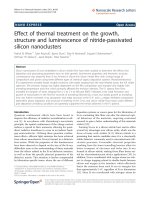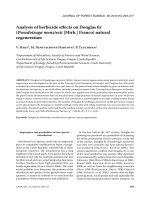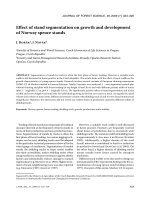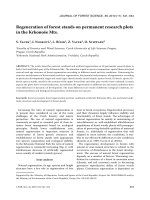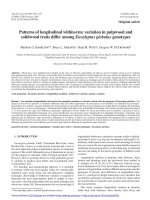Báo cáo lâm nghiệp: " period of glyphosate treatment on oak seedlings: phenological and physiotogical aspects" pptx
Bạn đang xem bản rút gọn của tài liệu. Xem và tải ngay bản đầy đủ của tài liệu tại đây (314.95 KB, 4 trang )
Effects
of
the
period
of
glyphosate
treatment
on
oak
seedlings:
phenological
and
physiotogical
aspects
C. Fabert
1
H.
Frochot
1
P.
Dizengremel
2
1
Station
de
Sylviculture,
INRA-CRF,
Champenoux,
54280
Seicham,os,
and
2
Laboratoire
de
Physiologie
V6g6tale
et
Forestibre,
Universit6
de
Nancy
I,
BP
239,
54506
Vandceuvre-les-Nancy,
France
Introduction
Young
oak
trees
are
very
sensitive
to
weed
competition,
especially
brambles
(Rubus
fruticosus
L.).
Bramble
control
is
essential
during
the
first
years
of
esta-
blishment
of
oak
regenerations.
Glyphosate
(N phosphonomethylglycine)
enables
good
control
when
applied
in
winter
to
green
brambles
(Frochot
and
Wehrlen, 1983).
However,
the
tolerance
of
oak
seedlings
to
the
glyphosate
treatments
during
the
vegetative
rest
period
was
not
clearly
established.
Previous
studies
demon-
strated
that
glyphosate
applied
during
the
dormant
period
did
not
affect
poplar
growth
(Netzer
and
Hauser,
1983).
Unfor-
tunately
this
herbicide
sometimes
causes
injuries
to
oak
seedlings.
Young
oaks
were
shown
to
be
as
equally
affected
by
glyphosate
applied
at
the
beginning
as
at
the
end
of
the
rest
period
(Frochot
et
al.,
1981).
). In
this
study,
we
analyzed
the
effects
of
the
period
of
herbicide
appli-
cation
on
phenological
and
physiological
characteristics
of
oak
seedlings.
Materials
and
Methods
1
yr
old
oak
seedlings
(Quercus
petraea
(M.)
Liebl.)
were
grown
on
fertilized
peat
in
individual
containers.
Each
treatment
and
control
consisted
of
24
seedlings.
Experiments
were
carried
out
in
a
climate
chamber
simulating
autumn
and
winter
conditions
during
8
periods
of
14
d
each.
These
periods
were
characterized
by
ranges
of
medium
(1,
5,
f!),
high
(2,
4,
6)
and
low
(3,
7)
temperatures
(Fig.
1
The
seedlings
were
subjected
to
an
accidental
period
of
low
temperature
indicated
by
an
asterisk.
The
day-night
regime
was
established
as
follows:
8
h
d
at
a
temperature
equal
to
the
maximum
average
temperature
of
the
corresponding
period
(cf.
Fig.
1).
).
All
seedlings
were
subjected
to
the
same
climatic
sequences
(1-8).
8
groups
of
seedlings
were
subjected
to
a
single
herbicide
application
at
8
different
periods,
treatment
Tn
being
applied
in
the
middle
of
the
period
of
temperature
n.
Glyphosate
2160
g/ha
(6
1/ha
Roundup)
in
aqueous
solution
was
applied
with
an
automatic
sprayer.
The
height
of
main
shoots
was
measured
during
the
following
July.
Some
enzyme
activities
linked
to
carbohydrate
breakdown
pathways
were
measured
in
leaves
(nkat-mg-
I
protein)
during
the
spring
following
the
herbicide
application:
NAD-gal-3-PDH
or
NAD-
gluyceraldehyde-3-phosphate
dehydrogenase
(cytosolic
glycolysis)
and
NADP-gal-3-PDH
or
NADP-glyceraldehyde-3-phosphate
dehydro-
genase
(chloroplastic
pathway)
(Heber
et
al.,
1963).
Fumarase
(Hatch,
1978)
and
NAD-malic
(NAD-ME)
(Grover
et
al.,
1981;
Gerant
et
al.,
1989)
were
used
as
mitochondrial
markers.
A
pentose
phosphate
pathway
enzyme
(G-6-PDH
or
glucose-6-phosphate
dehydrogenase)
was
also
measured
(Pitel
and
Cheliak,
1986).
Results
Phenological
effects
All
treatments
showed
a
significant
depressive
effect
on
shoot
elongation
as
compared
to
the
control
(Fig.
2).
A
maximum
effect
was
observed
for
T!
and
T2,
and
later
for
T!
and
T 8’
Glyphosate
caused
symptoms
of
phytotoxicity,
stretch-
ing
and
thickening
of
the
leaves,
and
shortening
of
the
shoots.
Damage
was
particularly
marked
in
the
first
treatments
(T!
and
T2)
and
decreased
from
T2
to
T8.
Only
a
few
alterations
were
still
apparent
in
the
last
treatment
(T
8
).
Enzyme
activities
in
leaves
Decreases
in
the
activities
of
NAD-ME,
fumarase,
NAD-
and
NADP-gal-3-PDH
were
observed
(Fig.
3),
especially
for
the
autumn
and
spring
treatments.
In
contrast,
the
G-6-PDH
activity
was
strikingly
stimu-
lated
by
treatments
T!
and
T2.
The
mag-
nitude
of
the
changes
in
enzyme
activities
was
more
marked
for
autumnal
treatments
than
for
winter
treatments.
Discussion
A
period
of
6
mo
separated
the
winter
gly-
phosate
treatments
from
the
physiological
and
phenological
analyses
carried
out
after
bud-break.
These
results
show
clearly
that
effects
of
glyphosate
were
never
correlated
with
temperature.
On
the
other
hand,
maximum
depressive
effects
appeared
following
autumn
application
and
later
with
application
just
before
bud-
break.
They
indicate
a
possible
seasonal
effect.
However,
the
temperatures
used
during
the
experiment
did
not
take
into
account
possible
peaks
of
low
tem-
perature
or
moisture
variations.
A
decrease
in
all
enzyme
activities
was
commonly
observed
except
for
treatments
T!
and
T2,
when
herbicide
was
applied
in
autumn
with
normal
and
high
tem-
peratures.
This
corresponds
to
deep
growth
disturbances.
The
increases
in
G-
6-PDH
activity
observed
in
the
first
2
treatments
might
be
linked
to
severe
stress,
possibly
revealing
the
synthesis
of
compounds
linked
to
thick
cellular
growth,
as
has
often
been
observed
(Dizengremel
and
Citerne,
1989;
Koziol
et al.,
1988).
These
preliminary
results
show
that
there
is
a
cortical
penetration
of
glypho-
sate
during
the
cold
season,
particularly
important
at
the
end
of
the
summer
growth
period
and
just
before
bud-break.
The
marked
changes
in
enzyme
activities
re-
veal
a
sensitivity
of
oak
seedlings
to
glyphosate,
as
shown
clearly
by
shoot
growth
reduction,
mainly
when
the
her-
bicide
was
applied
at
the
beginning
of
the
autumnal
period.
References
Dizengremel
P.
&
Citerne
A.
(1988)
Air
pollutant
effects
on
mitochondria
and
respiration.
In:
Air
Pollution
and
Plant
Metabolism.
(Schulte-
Hostede
S.,
Derrall
N.M.,
Blank
L.W.
&
Wellburn
A.R.,
eds.),
Elsevier,
London,
pp.
169-
188
Frochot
H.
&
Wehrlen
L.
(1983)
Efficacit
6
d’herbicides
sur
la
ronce
(Rubus
fruticosus
L.)
en
for6t
pendant
la
saison
froide.
In:
12e
Conference
Columa,
Unesco,
Paris.
3,
345-352
Frochot
H.,
Pitsch
M.
&
Wehrlen
L.
(1981)
S61ectivitd
du
glyphosate
en
fonction
de
la
dose
appliqu6e
et
du
stade
v6g6tatif
des
jeunes
plants
forestiers,
r6sineux
et
feuillus.
In:
11
e
Conf6rence
Columa,
ANPP,
Paris.
2,
545-553
Gerant
D.,
Citerne
A.,
Fabert
C.
&
Dizengremel
P.
(1989)
Extraction
and
study
of
enzymes
linked
to
malate
metabolism
in
tree
leaves.
Ann.
Sci.
For.
46
suppl.,
811 s-814s
Grover
S.D.,
Canellas
P.F.
&
Wedding
R.T
(1981 )
Purification
of
NAD
malic
enzyme
from
potato
and
investigations
of
some
physical
and
kinetic
properties.
Arch.
Biochem.
Biophys.
209,
396-407
Hatch
M.D.
(1978)
A
simple
spectrophotometric
assay
for
fumarate
hydratase
in
crude
tissue
extracts.
Ann.
Biochem.
85,
271-275
Heber
U.,
Pon
N.G.
&
Heber
M.
(1963)
Localization
of
carboxy
dismutase
and
triose
phosphate
dehydrogenase
in
chloroplasts.
Plant
Physiol.
38,
355-360
Koziol
M.J.,
Whatley
F.R.
&
Sheivey
J.D.
(1988)
An
integrated
view
of
the
effects
of
gaseous
air
pollutants
on
plant
carbohydrate
metabolism.
In:
Air
Pollution
and
Plant
Metabolism.
(Schulte-
Hostede
S.,
Darrall
N.M.,
Blank
L.W.
&
Wellburn
A.R.,
eds.),
Elsevier,
London,
pp.
148-
168
Netzer
D.A.
&
Hauser
E.A.
(1983)
Controlling
weeds
in
poplar
by
dormant
season
glyphosate
overspray.
North
Central
Weed
Control
Con-
ference 38, 141-142
Pitel
J.A.
&
Cheliak
W.M.
(1986)
Effectiveness
of
protective
agents
for
increasing
activity
of
five
enzymes
from
vegetative
tissues
of
white
spruce.
Can.
J.
Bot.
64,
39-44
